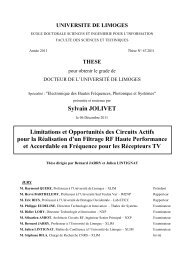Etude d'un procédé de gazéification de biomasse en ambiance ...
Etude d'un procédé de gazéification de biomasse en ambiance ...
Etude d'un procédé de gazéification de biomasse en ambiance ...
Create successful ePaper yourself
Turn your PDF publications into a flip-book with our unique Google optimized e-Paper software.
Résumé<br />
________________________________________________________________________________________________________________<br />
ABSTRACT<br />
A process for ligno-cellulosic biomass gasification is proposed: it allows to obtain a<br />
synthesis gas (mixture of CO and H2) that may be used for the production of liquid fuels. The<br />
curr<strong>en</strong>t processes pres<strong>en</strong>t drawbacks: they need a preparation of the biomass (drying and<br />
grinding), they produce pollutants (CO2, CH4 and tars) and biomass ash extraction may<br />
induce ph<strong>en</strong>om<strong>en</strong>a of fouling of the process.<br />
The process, consi<strong>de</strong>red here, proposes an original way of heating to eliminate some of<br />
these drawbacks or at least to strongly <strong>de</strong>crease them. It is based on an electric arc transferred<br />
betwe<strong>en</strong> two graphite electro<strong>de</strong>s above a glass melt. Biomass is introduced by gravity at the<br />
top of the furnace and falls insi<strong>de</strong> the arc volume on the melt surface.<br />
The <strong>en</strong>ergy, nee<strong>de</strong>d for the <strong>en</strong>dothermic gasification reactions is provi<strong>de</strong>d by the electric<br />
arc and not by the consumption of a part of the biomass, that allows to increase the<br />
conversion yield of the biomass. So the high temperature (more than 1200°C) favors the<br />
gasification and <strong>de</strong>creases the formation of unwanted by-products by increasing tars<br />
cracking.<br />
The mineral melt has various functions. On one hand it allows "to store" insi<strong>de</strong> the <strong>en</strong>ergy<br />
of the electric arc to transfer it to the biomass, increasing the <strong>en</strong>ergy yield. On the other hand<br />
it allows to increase the resi<strong>de</strong>nce time of the particle in the hot atmosphere and therefore to<br />
avoid the biomass crushing. Furthermore, the mineral melt allows the incorporation of the<br />
remaining ashes.<br />
Besi<strong>de</strong>s the usual humidity of the wood (~ 20 % (mass)) provi<strong>de</strong>s directly in the<br />
atmosphere of the furnace the water necessary for the reaction of gasification:<br />
C6H9O4 + 2 H2O → 6 CO + 6,5 H2; so the stage of preliminary drying is avoi<strong>de</strong>d.<br />
Trials of beech wood gasification have be<strong>en</strong> run with temperatures betwe<strong>en</strong> 1200 and<br />
1600°C:<br />
- CO2 and CH4 are formed in small quantities, lower than 1 % (volume) for the first one<br />
and on the or<strong>de</strong>r of 0,01 % for the second,<br />
- the quantity of tars <strong>de</strong>tected during trials is on the or<strong>de</strong>r of about 10 mg.Nm -3 ,<br />
- the conversion yield of CO from the biomass is betwe<strong>en</strong> 52 and 68 % and the one of H2<br />
is betwe<strong>en</strong> 60 and 68 %,<br />
- the optimal temperature for the process is about 1300°C: the conversion yield of carbon<br />
in dry biomass to CO is about 98 %(mass).<br />
A simplified mo<strong>de</strong>l for the thermal transfer to biomass particle shows that the<br />
resi<strong>de</strong>nce time corresponds with time obtained experim<strong>en</strong>tally and allows to <strong>en</strong>visage a first<br />
sizing for an industrial reactor.<br />
A technico-economic approach was ma<strong>de</strong> from these results: the competitiv<strong>en</strong>ess of<br />
this process <strong>de</strong>p<strong>en</strong>ds strongly on the <strong>en</strong>ergy return on the reactor; but the additional cost<br />
<strong>en</strong>g<strong>en</strong><strong>de</strong>red by the lack of optimization is comp<strong>en</strong>sated by the <strong>de</strong>crease of the costs of<br />
biomass preparation and of the gas cleaning.<br />
Key words: Gasification, biomass, thermal plasma, mineral bath, high temperature, sized<br />
c<strong>en</strong>timeter particles.<br />
iv
















